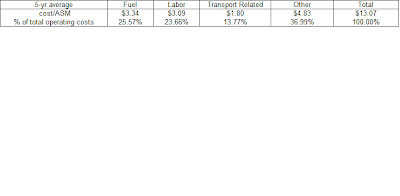The cost structure of airlines has undergone some drastic change in the last decade. The cost structure was relatively stable through the 1990's with the only major change being the steady decline in commissions – a likely fallout of passengers dealing with airlines more directly, possibly through the internet.
Since 1999-2000, however, this cost structure started to change quite remarkably. Starting 2002, the portion airlines spent on fuel started to rise steadily – this was a result of two developments. One, the steady rise in the price of aviation jet fuel (average jet fuel cost/bbl rose from $22 in 2000 to $128 in 2008). Second, airlines were able to extract concessions from unions during the spate of bankruptcies that followed 9/11 and the ensuing recession. As a result, fuel, as a percentage of total operational costs, almost doubled from 11.7% in 2002 to 22.4% in 2009. This was after touching 31.1% in 2008. In fact, for the three years from 2006 and 2008, fuel was in fact the single largest operating expense for airlines.
Noticeably, labor too is the large component in airlines' cost structure. Airlines spent anywhere between 3 and 3.25 cents on labor for each ASM. Labor thus accounts for almost a quarter of operational cost. While labor costs have decreased as a percentage of total operating expense, the amount airlines spend on labor per ASM has been fairly stable ranging from a low of 2.91 cents/ASM in 1990 (31.6% of operational expense) to 4.04 cents (38% of operating expense) in 2002. In 2009, airlines spent 3.26 cents/ASM accounting for 25.3% of their operating costs. This is in stark contrast to fuel which ranged from 1.34 cents/ASM in 1998 (9.9% of all operating expenses) to 5.87 cents/ASM (31.1% of operating expenses) in 2008. In 2009, airlines spent 3.59 cents/ASM in fuel, accounting for 22.4% of all operating expense.
The amount airlines spent on labor also reflects any productivity gains that may or may not have occurred, the impact of automation that may have made some labor obsolete (passengers checking-in online), policy changes – checked bag fee has resulted in substantial drop in checked bag volume requiring less labor. Similarly, fuel costs would reflect any improvements in the fuel efficiency of jets.
The third interesting cost item is transport-related expenses, which now account for 1.80 cents/ASM or 14% of operating expense. Transport-related expenses, according to the DOT, include transfer payments to express/regional carriers, costs associated with running a gift shop or serving liquor and food on-board or for performing maintenance for other airlines. This cost item in fact, almost doubled from 2003 to 2004 from 0.88 to 1.36 cents/ASM. Although the exact causes of this increase are not known, it is quite likely that increase is a result of a greater use of regional carriers to serve smaller, less strategic, routes.
 |
The third interesting cost item is transport-related expenses, which now account for 1.80 cents/ASM or 14% of operating expense. Transport-related expenses, according to the DOT, include transfer payments to express/regional carriers, costs associated with running a gift shop or serving liquor and food on-board or for performing maintenance for other airlines. This cost item in fact, almost doubled from 2003 to 2004 from 0.88 to 1.36 cents/ASM. Although the exact causes of this increase are not known, it is quite likely that increase is a result of a greater use of regional carriers to serve smaller, less strategic, routes.


No comments:
Post a Comment